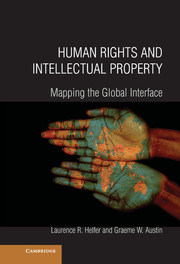Book contents
- Frontmatter
- Contents
- Preface
- 1 Mapping the Interface of Human Rights and Intellectual Property
- 2 The Human Right to Health, Access to Patented Medicines, and the Restructuring of Global Innovation Policy
- 3 Creators' Rights as Human Rights and the Human Right of Property
- 4 Rights to Freedom of Expression, to Cultural Participation, and to Benefit from Scientific Advancements
- 5 The Right to Education and Copyright in Learning Materials
- 6 The Human Right to Food, Plant Genetic Resources, and Intellectual Property
- 7 Indigenous Peoples' Rights and Intellectual Property
- 8 Conclusion
- References
- Acknowledgments
- Index
- Cases Discussed (Selected)
Preface
Published online by Cambridge University Press: 05 June 2012
- Frontmatter
- Contents
- Preface
- 1 Mapping the Interface of Human Rights and Intellectual Property
- 2 The Human Right to Health, Access to Patented Medicines, and the Restructuring of Global Innovation Policy
- 3 Creators' Rights as Human Rights and the Human Right of Property
- 4 Rights to Freedom of Expression, to Cultural Participation, and to Benefit from Scientific Advancements
- 5 The Right to Education and Copyright in Learning Materials
- 6 The Human Right to Food, Plant Genetic Resources, and Intellectual Property
- 7 Indigenous Peoples' Rights and Intellectual Property
- 8 Conclusion
- References
- Acknowledgments
- Index
- Cases Discussed (Selected)
Summary
The key terms in this book's subtitle – “mapping,” “global,” and “interface” – reflect our approach to analyzing the relationship between human rights and intellectual property.
Consider first the cartographical trope, “mapping.” It is possible to envision intellectual property law and human rights law as the product of the gradual accretion and spread of international and domestic laws and institutions. The terrain of international intellectual property law was the first to emerge. Initially the subject of discrete bilateral agreements between sovereign nations, its modern form came to be established with the two great multilateral intellectual property treaties from the end of the 19th century: the Paris Convention on industrial property (1883) and the Berne Convention on literary and artistic works (1886). The international human rights regime emerged more recently, with the founding of the United Nations after World War II, and, in particular, the adoption of the Universal Declaration of Human Rights (1948).
From these beginnings, the terrain occupied by both issue areas has expanded significantly in substantive reach, in prescriptive detail, and in geographic scope. In the intellectual property context, the international law relating to patents illustrates this point. At the end of the 19th century, the desirability of domestic – let alone international – patent protection was a matter of sharp debate, even among industrialized nations. For this reason, the Paris Convention contains few substantive rules – although its national treatment and international priority rules for patent registrations were important achievements – and (like the Berne Convention) it has no effective enforcement mechanisms.
- Type
- Chapter
- Information
- Human Rights and Intellectual PropertyMapping the Global Interface, pp. xi - xviPublisher: Cambridge University PressPrint publication year: 2011



